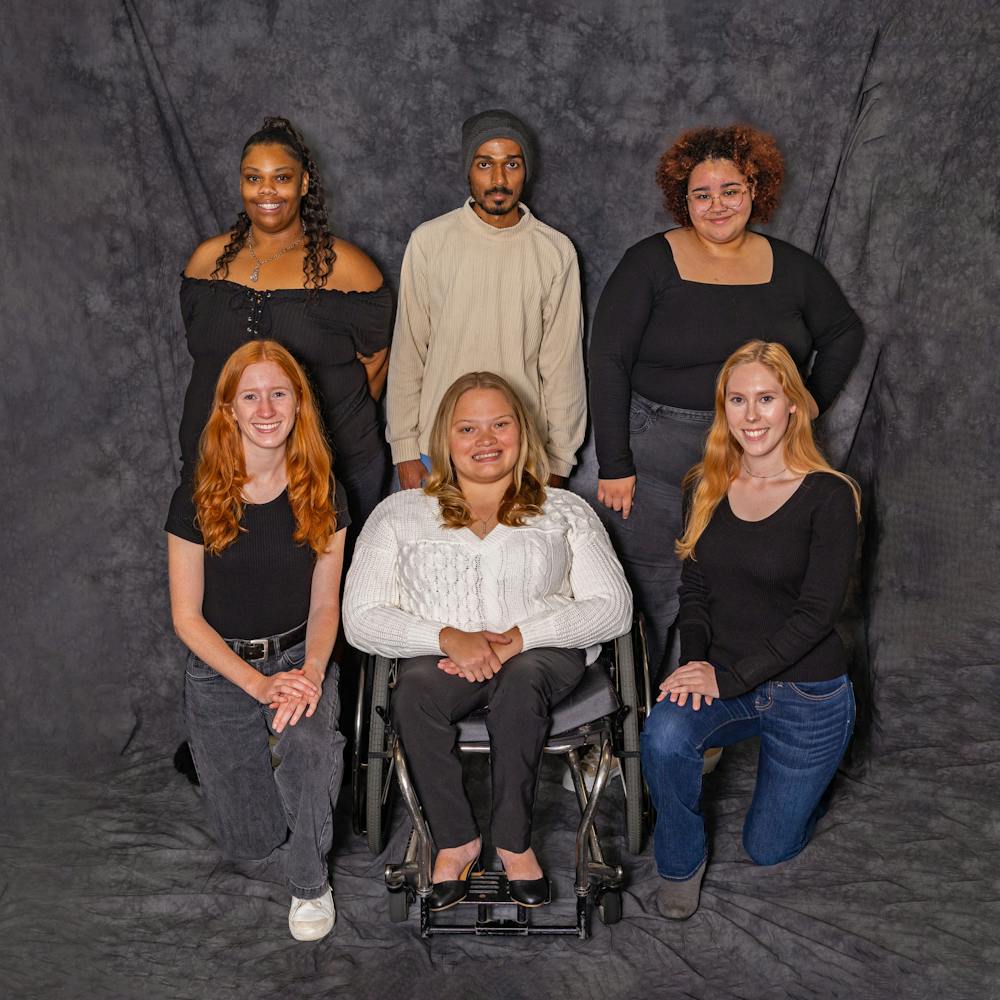Not just seen but heard
Our newsroom strives to represent different voices and different beauty

(Top row from left) Senior Paige Davis, graduate student Nirav Patel and sophomore Odessa Watson, (bottom row from left) graduate student Anya Turner, junior Eleanor Dolata, and freshman Faith Phillips pose for a studio portrait, Tuesday, Oct. 10, in Moore Hall.
There comes a time in every young woman’s life where she begins to strive for a perfect body. Except it’s not just women. And it’s not just young people.
Most importantly, perfection is a laughable impossibility.
Members of the Central Michigan Life newsroom have long been dedicated to being the student voice on campus. But as technology opens up new opportunities for different types of media, we are determined to continue representing a beautifully diverse viewership.
That means different shapes, sizes, colors, orientations and identities.
As a media organization, we recognize the role various other forms of media have played in the past when it comes to body image.
Social media and history
The National Library of Medicine published the results of a study on the connection between the use of Instagram and the body image of young girls.
“Our final model results show that browsing on Instagram was associated with lower levels of body appreciation, fully mediated by upward social comparison with social media influencers,” according to the NLM.
But it doesn’t start with social media. There’s a long history of changing social expectations for women’s bodies, especially in Western and European cultures.
An article by Glam showcases these changes over time:
• Paleolithic era: full-bodied women as a sign of fertility
• Ancient Egypt: hourglass shapes and symmetry
• Classical age in Ancient Greece: larger, curvier and plump
• Middle ages: not having the plague
• Renaissance: emphasis on curves and brown eyes
• Regency era: slender and tall; think Netflix’s “Bridgerton”
• Victorian era: petite and delicate with cinched waists
• Industrialization era: petite curves, curls and bedroom eyes
• Roaring ‘20s: slender and androgynous
• 1930s-1950s: curves, curves, curves; think Marilyn Monroe
• 1960s-1990s: extremely thin supermodel look
All of these changes show that beauty not only comes in all shapes and sizes, but is a changing concept that one body shouldn’t be expected to exemplify all the time.
There’s a darker side to poor body image. And it comes in the form of unhealthy “fixes,” like questionable diet pills and disordered eating.
Entertainment media influence on eating disorders
If it’s not coming directly from social media influencers, eating disorders are chronically romanticized in entertainment media. When you see disordered eating in a movie or T.V. show, more often than not it’s a young white girl with anorexia. But that’s not the whole story.
According to the National Association of Anorexia Nervosa and Associated Disorders (ANAD), there are disparities in diagnosis and treatment for minority groups.
ANAD listed Black, Indigenous People of Color (BIPOC) as more likely to experience symptoms of disordered eating, but less likely to be diagnosed or asked about it by their doctor.
The trend continues for members of the LGBTQ+ community. Transgender college students are listed by ANAD to experience disordered eating at four times the rate of their cisgender classmates. And 87% of LGBTQ+ people say they’re dissatisfied with their body, 7% higher than their straight counterparts.
What about the stereotype of the skinny girl with an eating disorder? That’s still around, and it has an impact.
ANAD lists people with larger bodies as half as likely to be diagnosed with an eating disorder than people who are “underweight” or at a “normal weight.”
“Larger body size is both a risk factor for developing an eating disorder and a common outcome for people who struggle with bulimia and binge eating disorder,” according to ANAD.
What about men?
The range of media represented body types for men is small, going from beer-bellied dad bod to muscle machine with little-to-no middle ground.
Even in some fantasy books there aren’t a lot of options: The male lead and romantic interest is tall with dark hair and a powerful presence. We’ve seen men more often than women posting unsolicited comments on social media, but that doesn’t mean men aren’t painfully aware of their own physique, or even struggling with it.
According to the Better Health Channel, there are some behaviors that indicate poor body image and disordered eating in men:
• Excessive dieting
• Periods of binge eating
• Compensating for food consumption with purging and excessive exercise
• Steroid misuse
But something that’s different for men and women are aging standards.
We’ve seen more men represented as attractive as they age, from young men to fathers with dad bods to the stereotypical “silver fox.” Women on the other hand, not really.
Young women are represented in movies as attractive, but we haven’t seen middle-aged women considered appealing or even represented until they reach the age of Medicare eligibility.
So where does that leave us? People of every age have contributions to make to the world, whether it’s wisdom earned from years of experience, a workforce of skillsets or new ideas. And that has nothing to do with physical appearance.
Into the future
For the past year CM Life has been committed to being open with who people are. They haven’t been posed to hide socially perceived flaws in photos.
We are uniquely able to model what we want to see in this conversation and the media industry, putting photos of people of all types of beauty in front of 300,000 over the course of the year.
It is not only our responsibility to uplift voices that go unheard, but people who go unseen. And we’re ready to explore this possibility.



